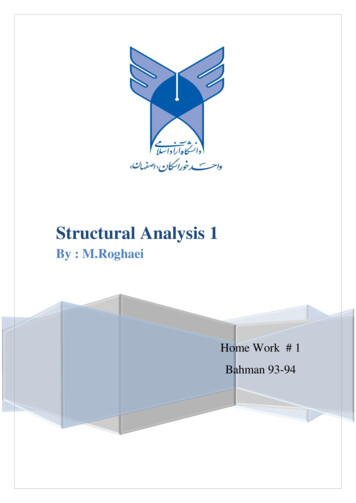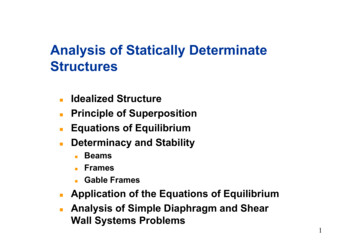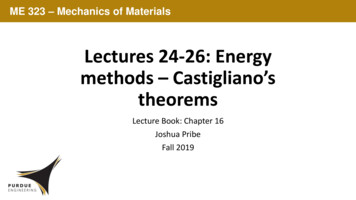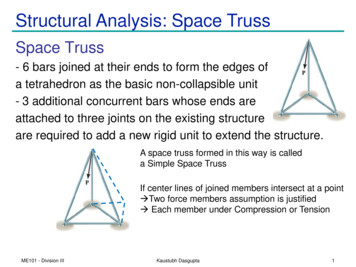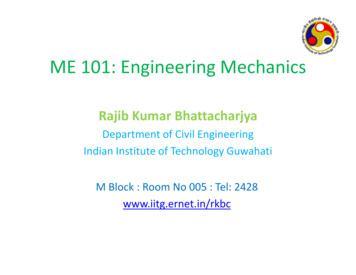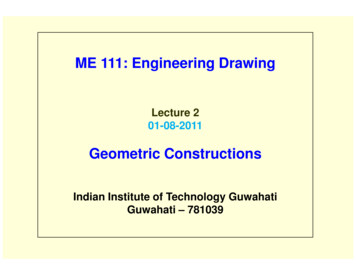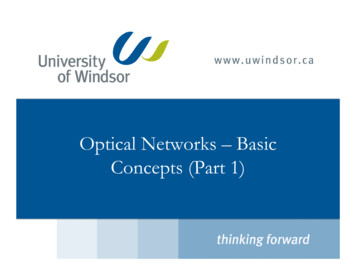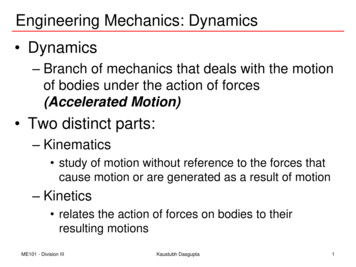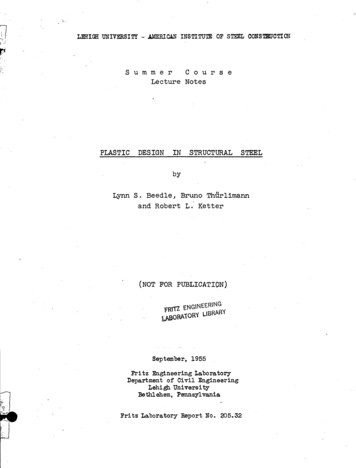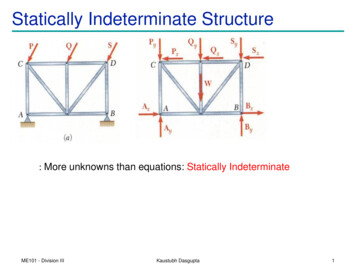
Transcription
Statically Indeterminate Structure: More unknowns than equations: Statically IndeterminateME101 - Division IIIKaustubh Dasgupta1
Plane Truss :: DeterminacyNo. of unknown reactions 3No. of equilibrium equations 3: Statically Determinate (External)No. of members (m) 9No. of joints (j) 6No. of unknown reactions (R) 3 m R 2j: Statically Determinate (Internal)ME101 - Division IIIKaustubh Dasgupta2
Plane Truss :: DeterminacyPresence of internal members: Additional sharing for forces: Additional StabilityFurther addition of internal membersF: Strengthening of Joints C and F: Additional Stability and forcesharingC: m R 2j: Statically Indeterminate (Internal)ME101 - Division IIIKaustubh Dasgupta3
Plane Truss :: DeterminacyWhen more number of members/supports are present than areneeded to prevent collapse/stability Statically Indeterminate Truss cannot be analysed using equations of equilibrium alone! additional members or supports which are not necessary formaintaining the equilibrium configuration RedundantExternal and Internal RedundancyExtra Supports than required External Redundancy– Degree of indeterminacy from available equilibrium equationsExtra Members than required Internal RedundancyME101 - Division IIIKaustubh Dasgupta4
Plane Truss :: DeterminacyInternal Redundancy orDegree of Internal Static IndeterminacyExtra Members than required Internal RedundancyEquilibrium of each joint can be specified by two scalar force equations 2j equations for a truss with “j” number of joints Known QuantitiesFor a truss with “m” number of two force members, and maximum 3unknown support reactions Total Unknowns m 3(“m” member forces and 3 reactions for externally determinate truss)m 3 2j Statically Determinate Internallym 3 2j Statically Indeterminate Internallym 3 2j Unstable TrussME101 - Division IIIKaustubh Dasgupta5
Plane Truss :: Analysis MethodsWhy to Provide Redundant Members? To maintain alignment of two members during construction To increase stability during construction To maintain stability during loading (Ex: to prevent bucklingof compression members) To provide support if the applied loading is changed To act as backup members in case some members fail orrequire strengthening Analysis is difficult but possibleME101 - Division IIIKaustubh Dasgupta6
Plane Truss :: Analysis MethodsZero Force MembersME101 - Division IIIKaustubh Dasgupta7
Plane Truss :: Analysis MethodsZero Force Members: Simplified StructuresME101 - Division IIIKaustubh Dasgupta8
Plane Truss :: Analysis MethodsZero Force Members: Conditions if only two noncollinear members form a truss joint and noexternal load or support reaction is applied to the joint, the twomembers must be zero force members if three members form a truss joint for which two of themembers are collinear, the third member is a zero-forcemember provided no external force or support reaction isapplied to the jointME101 - Division IIIKaustubh Dasgupta9
Structural Analysis: Plane TrussSpecial Condition When two pairs of collinear members are joined as shown infigure, the forces in each pair must be equal and opposite.ME101 - Division IIIKaustubh Dasgupta10
Plane Truss :: Analysis MethodsMethod of Joints Start with any joint where at least one known load existsand where not more than two unknown forces are present.FBD of Joint A and members AB and AF: Magnitude of forces denoted as AB & AF- Tension indicated by an arrow away from the pin- Compression indicated by an arrow toward the pinMagnitude of AF fromMagnitude of AB fromAnalyze joints F, B, C, E, & D in that order to complete the analysisME101 - Division IIIKaustubh Dasgupta11
Method of Joints: ExampleDetermine the force in each member of the loaded truss byMethod of Joints.Is the truss statically determinant externally?Is the truss statically determinant internally?Are there any Zero Force Members in the truss?ME101 - Division IIIKaustubh DasguptaYesYesNo12
Method of Joints: ExampleSolutionME101 - Division IIIKaustubh Dasgupta13
Method of Joints: ExampleSolutionME101 - Division IIIKaustubh Dasgupta14
Structural Analysis: Plane TrussMethod of Joints: only two of three equilibrium equationswere applied at each joint because the procedures involveconcurrent forces at each joint Calculations from joint to joint More time and effort requiredMethod of SectionsTake advantage of the 3rd or moment equation ofequilibrium by selecting an entire section of truss Equilibrium under non-concurrent force system Not more than 3 members whose forces areunknown should be cut in a single section sincewe have only 3 independent equilibrium equationsME101 - Division IIIKaustubh Dasgupta15
Structural Analysis: Plane TrussMethod of Sections Find out the reactions from equilibriumof whole truss To find force in member BE: Cut an imaginary section (dotted line) Each side of the truss section should remain in equilibrium– Apply to each cut member the force exerted on it by the member cut away– The left hand section is in equilibrium under L, R1, BC, BE and EF– Draw the forces with proper senses (else assume) Moment @ B EF L R1; Fy 0 BE Moment @ E and observation of whole truss BC– Forces acting towards cut section Compressive– Forces acting away from the cut section Tensile Find EF from MB 0 ; Find BE from Fy 0 Find BC from ME 0 Each unknown has been determined independently of the other twoME101 - Division IIIKaustubh Dasgupta16
Structural Analysis: Plane TrussMethod of Sections Principle: If a body is in equilibrium, then any part of thebody is also in equilibrium. Forces in few particular member can be directly found outquickly without solving each joint of the truss sequentially Method of Sections and Method of Joints can beconveniently combined A section need not be straight. More than one section can be used to solve a given problemME101 - Division IIIKaustubh Dasgupta17
Structural Analysis: Plane TrussMethod of Sections: ExampleFind out the internalforces in members FH,GH, and GIFind out the reactions M A 0 5 m 6 kN 10 m 6 kN 15 m 6 kN 20 m 1 kN 25 m 1 kN 30 m LL 7.5 kN Fy 0 20 kN L AA 12.5 kN ME101 - Division IIIKaustubh Dasgupta18
Method of Sections: Example Solution Pass a section through members FH, GH, andGI and take the right-hand section as a freebody.tan FG 8 m 0.5333GL 15 m 28.07 Apply the conditions for static equilibrium todetermine the desired member forces. MH 0 7.50 kN 10 m 1 kN 5 m FGI 5.33 m 0FGI 13.13 kNFGI 13.13 kN TME101 - Division IIIKaustubh Dasgupta19
Method of Sections: Example Solution MG 0 7.5 kN 15 m 1 kN 10 m 1 kN 5 m FFH cos 8 m 0FFH 13.82 kNFFH 13.82 kN Ctan GI5m 2 0.9375HI 3 8 m 43.15 ML 0 1 kN 10 m 1 kN 5 m FGH cos 15 m 0FGH 1.371 kNFGH 1.371 kN CME101 - Division IIIKaustubh Dasgupta20
Structural Analysis: Space TrussSpace TrussME101 - Division III3-D counterpart of the Plane TrussIdealized Space Truss Rigid linksconnected at their ends by ball andsocket jointsKaustubh Dasgupta21
Structural Analysis: Space TrussSpace Truss- 6 bars joined at their ends to form the edges ofa tetrahedron as the basic non-collapsible unit- 3 additional concurrent bars whose ends areattached to three joints on the existing structureare required to add a new rigid unit to extend the structure.A space truss formed in this way is calleda Simple Space TrussIf center lines of joined members intersect at a point Two force members assumption is justified Each member under Compression or TensionME101 - Division IIIKaustubh Dasgupta22
Structural Analysis: Space TrussStatic Determinacy of Space TrussSix equilibrium equations available to find out support reactions if these are sufficient to determine all support reactions The space truss is Statically Determinate ExternallyEquilibrium of each joint can be specified by three scalar force equations 3j equations for a truss with “j” number of joints Known QuantitiesFor a truss with “m” number of two force members, and maximum 6unknown support reactions Total Unknowns m 6(“m” member forces and 6 reactions for externally determinate truss)Therefore:necessary condition for Stabilitym 6 3j Statically Determinate Internally Abut not a sufficient condition sincem 6 3j Statically Indeterminate Internally one or more members can bearranged in such a way as not tom 6 3j Unstable Trusscontribute to stable configuration ofthe entire trussME101 - Division IIIKaustubh Dasgupta23
Structural Analysis: Space Truss Space Truss - 6 bars joined at their ends to form the edges of a tetrahedron as the basic non-collapsible unit - 3 additional concurrent bars whose ends are attached to three joints on the existing structure are required to add a new rigid unit to extend the structure.
